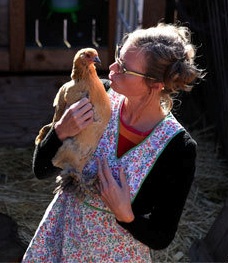 Just after writing the post below about the ways the recent economic crisis may have shifted cultural attitudes toward consumption and frugality, I picked up Daniel Bell’s classic Cultural Contradictions of Capitalism and found this:
Just after writing the post below about the ways the recent economic crisis may have shifted cultural attitudes toward consumption and frugality, I picked up Daniel Bell’s classic Cultural Contradictions of Capitalism and found this:
“What we owe to the future is a capacity to produce.”*
This concern for the future, I think, underlies many of the behaviors we associate with the habits of people who lived through the Great Depression. The meaning of all that patching and mending, of raising chickens in the backyard and so forth, was not just to reduce consumption expenses, but to conserve the resources they did have for production–for future-building.
Of course, the ability to fix things and grow your own food are themselves types of productive capacity. In less complex societies, with less division of labor, survival depended upon those skills. One had to be able to provide for most, if not all, of one’s own needs independently, or within the household unit.
By the time my grandparents were born, that was no longer the case: for example, both my paternal grandparents grew up in the city of Chicago, and had to buy clothes and some of their food from stores, rather than making everything themselves. This isn’t a bad thing–just a modern thing. As Emile Durkheim–one of the founding fathers of sociology–famously argued, specialization and the social division of labor are necessary conditions for the material and intellectual development of societies. His point was that if everyone had to attend to their own survival needs, rather than paying someone else to provide them with food, clothing, and other necessities, it would be difficult for any one person to pursue certain valuable but time-intensive specialties, like scientific research.
My grandparents didn’t have the family wealth necessary to specialize that much: the Great Depression cut short their educations, so that my grandmother had to drop out of school at 15 to begin earning money as a maid for wealthier families, and my grandfather (who had hoped to become a lawyer) made it only part way through an associate’s degree program before his tuition money ran out and joined the Marine Corps.
While their individual trajectories were curtailed by the Great Depression, their frugal habits meant they accumulated a surprising amount of productive capacity at the family level of analysis. Specifically, they were able to save enough so that their first child, my father, could get a good education at a private Catholic school, and then become the first person in the family to earn a college degree. My grandparents themselves continued to live very modestly–in their 60s, they subsisted on Social Security and lived in a single-wide trailer in Florida mobile home park.
But because they were able to give my father the benefit of all the productive capacity they’d accumulated–their savings from blue-collar jobs, and all the methods they used to avoid spending money in other ways–he was able to make big leap in upward mobility. That future-oriented momentum made it possible for me to go even farther, so that the granddaughter of a woman who had to leave school in the 10th grade could graduate with a PhD from Harvard 70 years later. My grandmother died a few years before I graduated, but I think of her and my grandfather often, not only because I loved them but because I feel obliged to keep building on what they started.
That’s where the satisfaction of fixing things comes from: I’m not only remembering people I loved through imitation, but perpetuating their legacy by conserving productive capacity in many of the same ways they did.
Thus, what economist Robert Solow has written of the intergenerational transmission of wealth also holds for cultural and social capital:
“We have actually done quite well at the hands of our ancestors. Given how poor they were and how rich we are, they might properly have saved less and consumed more. No doubt they never expected the rise in income per head that has made us so much richer than they ever dreamed was possible.”**
To the memories of Rose Marie Coglianese Harrington (1913-1996) and William Joseph Harrington (1911-1999).
__________
*Bell, Daniel. 1979. The Cultural Contradictions of Capitalism. London: Heinemann Educational Books. p. 273.
**Solow, Robert M. 1974. “The Economics of Resources or the Resources of Economics.” American Economic Review 64: 1-14.
